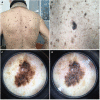Lead Time from First Suspicion of Malignant Melanoma in Primary Care to Diagnostic Excision: a Cohort Study Comparing Teledermatoscopy and Traditional Referral to a Dermatology Clinic at a Tertiary Hospital
- PMID: 36892392
- PMCID: PMC9946101
- DOI: 10.5826/dpc.1301a18
Lead Time from First Suspicion of Malignant Melanoma in Primary Care to Diagnostic Excision: a Cohort Study Comparing Teledermatoscopy and Traditional Referral to a Dermatology Clinic at a Tertiary Hospital
Abstract
Introduction: The increasing use of teledermatoscopy in clinical practice has led to demands to evaluate the effects of this new technology on traditional healthcare systems.
Objectives: To study lead times from first consultation in primary care to diagnostic excision of suspected malignant melanoma lesions in traditional referrals to a tertiary hospital-based dermatology clinic compared with mobile teledermatoscopy referrals.
Methods: A retrospective cohort study design was used. Data on sex, age, pathology, caregivers, clinical diagnosis, date for first visit to primary care unit, and date for diagnostic excision were collected from medical records. Patients managed through traditional referral (n=53) were compared with patients managed at primary care units using teledermatoscopy (n=128) regarding lead time from first visit to diagnostic excision.
Results: Mean time from date of first visit at primary care unit to diagnostic excision did not differ between the traditional referral and teledermatoscopy groups (16.2 vs. 15.7 days, median 10 vs. 13 days, p=0.657). Lead times from date of referral to diagnostic excision did not significantly differ (15.7 vs. 12.8 days, median 10 vs. 9 days, p=0.464).
Conclusions: Our study indicates that lead time to diagnostic excision for patients with suspected malignant melanoma managed by teledermatoscopy was comparable and not inferior to that of the traditional referral pathway. If teledermatoscopy is used at first consultation in primary care, it could potentially be more efficient than traditional referral.
Conflict of interest statement
Figures




References
LinkOut - more resources
Full Text Sources
